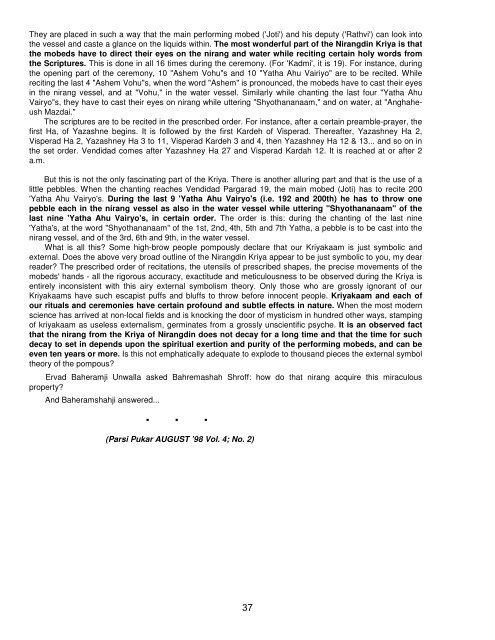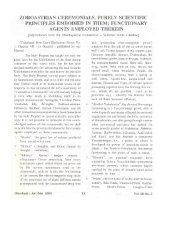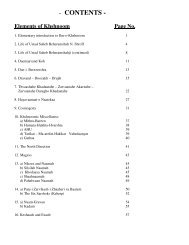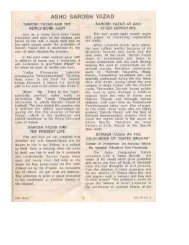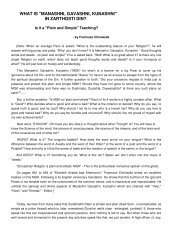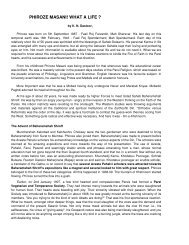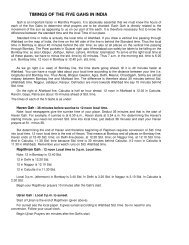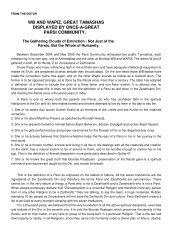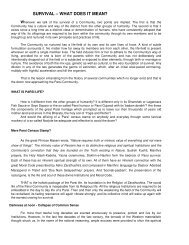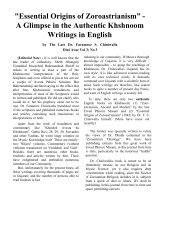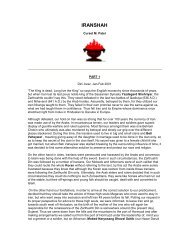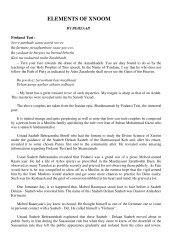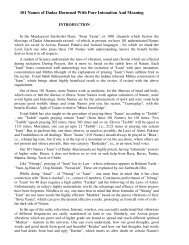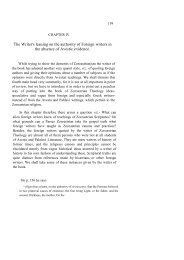Ilm-e-Khshnoom - Traditional Zoroastrianism: Tenets of the Religion
Ilm-e-Khshnoom - Traditional Zoroastrianism: Tenets of the Religion
Ilm-e-Khshnoom - Traditional Zoroastrianism: Tenets of the Religion
You also want an ePaper? Increase the reach of your titles
YUMPU automatically turns print PDFs into web optimized ePapers that Google loves.
They are placed in such a way that <strong>the</strong> main performing mobed ('Joti') and his deputy ('Rathvi') can look into<br />
<strong>the</strong> vessel and caste a glance on <strong>the</strong> liquids within. The most wonderful part <strong>of</strong> <strong>the</strong> Nirangdin Kriya is that<br />
<strong>the</strong> mobeds have to direct <strong>the</strong>ir eyes on <strong>the</strong> nirang and water while reciting certain holy words from<br />
<strong>the</strong> Scriptures. This is done in all 16 times during <strong>the</strong> ceremony. (For 'Kadmi', it is 19). For instance, during<br />
<strong>the</strong> opening part <strong>of</strong> <strong>the</strong> ceremony, 10 "Ashem Vohu"s and 10 "Yatha Ahu Vairiyo" are to be recited. While<br />
reciting <strong>the</strong> last 4 "Ashem Vohu"s, when <strong>the</strong> word "Ashem" is pronounced, <strong>the</strong> mobeds have to cast <strong>the</strong>ir eyes<br />
in <strong>the</strong> nirang vessel, and at "Vohu," in <strong>the</strong> water vessel. Similarly while chanting <strong>the</strong> last four "Yatha Ahu<br />
Vairyo"s, <strong>the</strong>y have to cast <strong>the</strong>ir eyes on nirang while uttering "Shyothananaam," and on water, at "Anghaheush<br />
Mazdai."<br />
The scriptures are to be recited in <strong>the</strong> prescribed order. For instance, after a certain preamble-prayer, <strong>the</strong><br />
first Ha, <strong>of</strong> Yazashne begins. It is followed by <strong>the</strong> first Kardeh <strong>of</strong> Visperad. Thereafter, Yazashney Ha 2,<br />
Visperad Ha 2, Yazashney Ha 3 to 11, Visperad Kardeh 3 and 4, <strong>the</strong>n Yazashney Ha 12 & 13... and so on in<br />
<strong>the</strong> set order. Vendidad comes after Yazashney Ha 27 and Visperad Kardah 12. It is reached at or after 2<br />
a.m.<br />
But this is not <strong>the</strong> only fascinating part <strong>of</strong> <strong>the</strong> Kriya. There is ano<strong>the</strong>r alluring part and that is <strong>the</strong> use <strong>of</strong> a<br />
little pebbles. When <strong>the</strong> chanting reaches Vendidad Pargarad 19, <strong>the</strong> main mobed (Joti) has to recite 200<br />
'Yatha Ahu Vairyo's. During <strong>the</strong> last 9 'Yatha Ahu Vairyo's (i.e. 192 and 200th) he has to throw one<br />
pebble each in <strong>the</strong> nirang vessel as also in <strong>the</strong> water vessel while uttering "Shyothananaam" <strong>of</strong> <strong>the</strong><br />
last nine 'Yatha Ahu Vairyo's, in certain order. The order is this: during <strong>the</strong> chanting <strong>of</strong> <strong>the</strong> last nine<br />
'Yatha's, at <strong>the</strong> word "Shyothananaam" <strong>of</strong> <strong>the</strong> 1st, 2nd, 4th, 5th and 7th Yatha, a pebble is to be cast into <strong>the</strong><br />
nirang vessel, and <strong>of</strong> <strong>the</strong> 3rd, 6th and 9th, in <strong>the</strong> water vessel.<br />
What is all this? Some high-brow people pompously declare that our Kriyakaam is just symbolic and<br />
external. Does <strong>the</strong> above very broad outline <strong>of</strong> <strong>the</strong> Nirangdin Kriya appear to be just symbolic to you, my dear<br />
reader? The prescribed order <strong>of</strong> recitations, <strong>the</strong> utensils <strong>of</strong> prescribed shapes, <strong>the</strong> precise movements <strong>of</strong> <strong>the</strong><br />
mobeds' hands - all <strong>the</strong> rigorous accuracy, exactitude and meticulousness to be observed during <strong>the</strong> Kriya is<br />
entirely inconsistent with this airy external symbolism <strong>the</strong>ory. Only those who are grossly ignorant <strong>of</strong> our<br />
Kriyakaams have such escapist puffs and bluffs to throw before innocent people. Kriyakaam and each <strong>of</strong><br />
our rituals and ceremonies have certain pr<strong>of</strong>ound and subtle effects in nature. When <strong>the</strong> most modern<br />
science has arrived at non-local fields and is knocking <strong>the</strong> door <strong>of</strong> mysticism in hundred o<strong>the</strong>r ways, stamping<br />
<strong>of</strong> kriyakaam as useless externalism, germinates from a grossly unscientific psyche. It is an observed fact<br />
that <strong>the</strong> nirang from <strong>the</strong> Kriya <strong>of</strong> Nirangdin does not decay for a long time and that <strong>the</strong> time for such<br />
decay to set in depends upon <strong>the</strong> spiritual exertion and purity <strong>of</strong> <strong>the</strong> performing mobeds, and can be<br />
even ten years or more. Is this not emphatically adequate to explode to thousand pieces <strong>the</strong> external symbol<br />
<strong>the</strong>ory <strong>of</strong> <strong>the</strong> pompous?<br />
Ervad Baheramji Unwalla asked Bahremashah Shr<strong>of</strong>f: how do that nirang acquire this miraculous<br />
property?<br />
And Baheramshahji answered...<br />
. . .<br />
(Parsi Pukar AUGUST ’98 Vol. 4; No. 2)<br />
37


